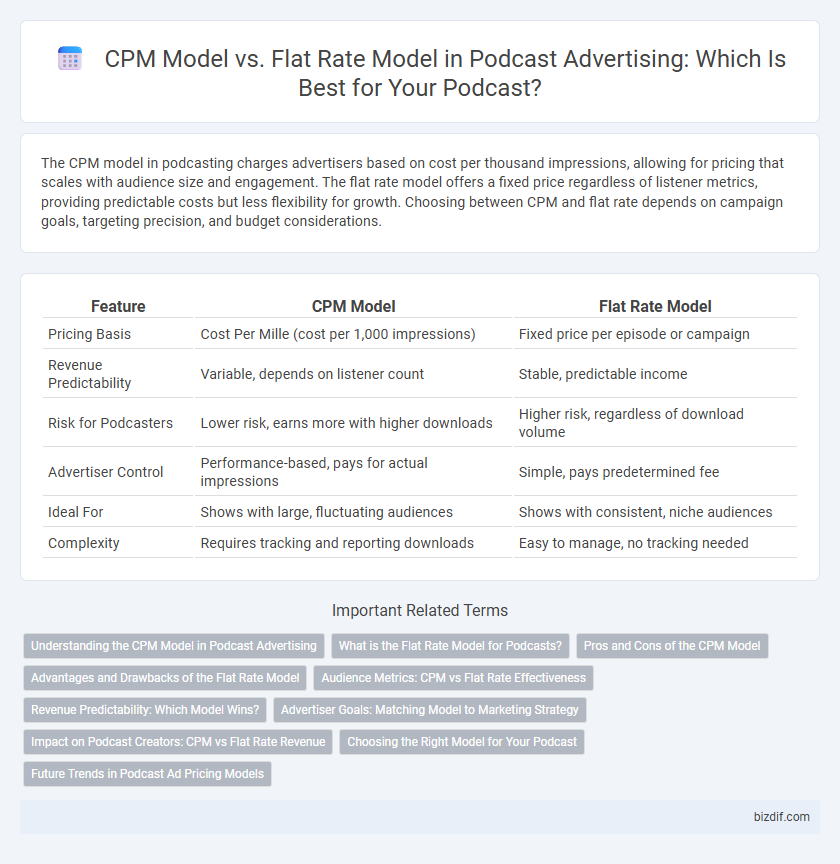The CPM model in podcasting charges advertisers based on cost per thousand impressions, allowing for pricing that scales with audience size and engagement. The flat rate model offers a fixed price regardless of listener metrics, providing predictable costs but less flexibility for growth. Choosing between CPM and flat rate depends on campaign goals, targeting precision, and budget considerations.
Table of Comparison
| Feature | CPM Model | Flat Rate Model |
|---|---|---|
| Pricing Basis | Cost Per Mille (cost per 1,000 impressions) | Fixed price per episode or campaign |
| Revenue Predictability | Variable, depends on listener count | Stable, predictable income |
| Risk for Podcasters | Lower risk, earns more with higher downloads | Higher risk, regardless of download volume |
| Advertiser Control | Performance-based, pays for actual impressions | Simple, pays predetermined fee |
| Ideal For | Shows with large, fluctuating audiences | Shows with consistent, niche audiences |
| Complexity | Requires tracking and reporting downloads | Easy to manage, no tracking needed |
Understanding the CPM Model in Podcast Advertising
The CPM (Cost Per Mille) model in podcast advertising charges advertisers based on every thousand ad impressions delivered within episodes, allowing precise targeting and performance tracking. This model offers dynamic pricing that scales with audience size and engagement, making it ideal for campaigns aiming to maximize ROI through measurable reach. Unlike flat rate models, CPM incentivizes podcasters to grow their listener base while providing advertisers with transparent cost-effectiveness linked directly to audience exposure.
What is the Flat Rate Model for Podcasts?
The Flat Rate Model for podcasts involves charging a fixed price for ad placements regardless of the number of listens or downloads, offering simplicity and predictability for advertisers and podcasters. This model contrasts with the CPM (Cost Per Mille) approach, which bases fees on every thousand impressions, allowing for performance-based pricing. Flat rate agreements are common in niche podcasts with loyal audiences where engagement metrics are less variable.
Pros and Cons of the CPM Model
The CPM (Cost Per Mille) model in podcast advertising charges advertisers based on every 1,000 listens, offering transparent and scalable pricing that aligns with audience size metrics. It benefits podcasters by rewarding growing listenership and providing predictable revenue tied directly to engagement levels. However, CPM can create revenue volatility during audience fluctuations and may undervalue niche podcasts with highly targeted but smaller audiences.
Advantages and Drawbacks of the Flat Rate Model
The flat rate model in podcast advertising offers simplicity and predictability, allowing advertisers to budget with a fixed cost regardless of audience size or engagement metrics. This model reduces complexity and administrative effort, making it attractive for smaller campaigns or sponsors seeking straightforward agreements. However, its drawback lies in potential undervaluation of high-performing shows, as podcasters may lose revenue opportunities if their actual CPM exceeds the flat rate agreed upon.
Audience Metrics: CPM vs Flat Rate Effectiveness
The CPM (Cost Per Mille) model leverages audience metrics by charging advertisers based on every thousand listens, ensuring payments align directly with actual listener engagement and reach. In contrast, the flat rate model offers a fixed price regardless of audience size or episode performance, often leading to variable advertiser ROI depending on podcast popularity. CPM's metric-driven pricing enhances effectiveness by incentivizing podcasters to grow and engage their audience, making it a preferred choice for data-driven advertising decisions.
Revenue Predictability: Which Model Wins?
The CPM model offers higher revenue predictability by tying income directly to ad impressions and listener engagement metrics, providing clearer performance-based earnings for podcasters and advertisers. In contrast, the flat rate model guarantees a fixed payment regardless of audience size or ad impact, which can limit potential revenue growth but ensures stable cash flow. By balancing these factors, the CPM model tends to win in maximizing revenue predictability through dynamic, data-driven monetization.
Advertiser Goals: Matching Model to Marketing Strategy
Advertisers aiming for efficient budget allocation often prefer the CPM model, as it charges based on impressions, aligning well with campaigns focused on brand awareness and audience reach. The flat rate model suits marketers seeking predictable costs and guaranteed placements, ideal for niche targeting or sponsorships with high listener engagement. Selecting a model that matches the advertiser's marketing strategy enhances campaign effectiveness and maximizes return on investment in podcast advertising.
Impact on Podcast Creators: CPM vs Flat Rate Revenue
The CPM (Cost Per Mille) model generates revenue based on the number of ad impressions, allowing podcast creators to scale their income proportionally with audience growth. In contrast, the Flat Rate model offers a fixed payment regardless of listenership, providing predictable but potentially limited earnings. For creators with rapidly expanding audiences, CPM can maximize revenue, while niche or smaller podcasts may benefit from the stability of flat rate agreements.
Choosing the Right Model for Your Podcast
Choosing the right monetization model for your podcast depends on your audience size and engagement. The CPM model, which pays per thousand listens, suits podcasts with large, active listenership for scalable revenue. In contrast, the flat rate model offers predictable income by charging a fixed fee, ideal for podcasts with niche audiences or stable advertiser relationships.
Future Trends in Podcast Ad Pricing Models
Emerging podcast ad pricing models are shifting from traditional CPM (Cost Per Mille) toward hybrid approaches that integrate flat rates and performance-based metrics to better capture listener engagement and ad effectiveness. Advances in data analytics and dynamic ad insertion enable advertisers to optimize spend by targeting specific demographics, driving a move away from static flat rate agreements. Future trends indicate a growing preference for flexible models combining CPM accuracy with flat rate simplicity to maximize ROI in podcast advertising.
CPM Model vs Flat Rate Model Infographic

 bizdif.com
bizdif.com